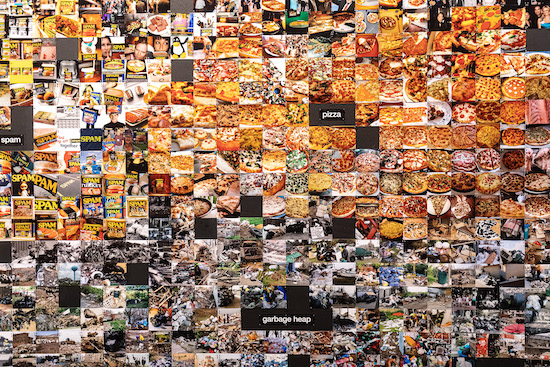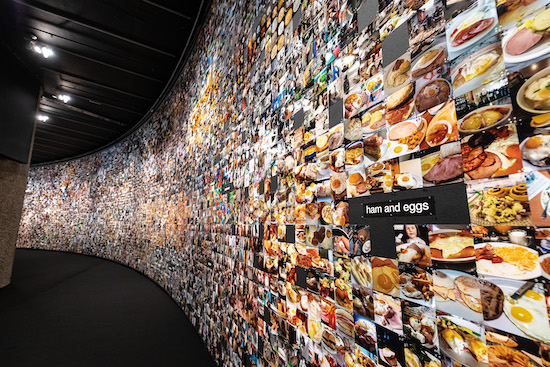Portrait of Artist Trevor Paglen. The Curve, Barbican. 26 September 2019 – 16 February 2020
© Tim P. Whitby / Getty Images
Running Trevor Paglen’s face through the Image Net Roulette app he developed with researcher Kate Crawford, the little green tag labels him a “micro-economist, micro-economic expert.” This is not, of course, an accurate description of the American author, artist, and digital provocateur’s profession. Since 2006 he has published books about CIA ‘black sites’ and extraordinary renditions, exhibited art works about secrecy and surveillance, winning multiple awards from the likes of Electronic Frontier Foundation and the Deutsche Börse Photography Foundation. He has never, to my knowledge, worked, published, or consulted on the themes of inflation, price mechanisms, or market failure. But then accuracy of description was never quite the point of Image Net Roulette.
The website, which allowed users to upload photos to be classified by a deep-learning framework trained on Image Net’s fourteen million-plus photographs into one or more of the 2,833 subcategories recognised by the widely-used picture data set, is intended to show what Paglen calls, “the deep forms of bias, prejudice, and cruelty that can be built into machine learning systems that classify people.”
As he wrote in the essay ‘Excavating AI’, coauthored with Crawford and published online at the same time as the app, Image Net Roulette was intended to “shed light on what happens when technical systems are trained using problematic training data.” Contestants in an annual machine vision competition have managed to achieve a 97.3% success rate recognising objects using neural networks trained on the data set. But that contest specifically excludes items in Image Net’s ‘person’ subcategory. With pictures tagged by anonymous Amazon Mechanical Turk users paid an average of two bucks an hour, Image Net’s non-object subcategories range from the seemingly innocent (“Boy Scout”, “Cheerleader”, “Grandfather”) to the more subjective – even offensive (“Hypocrite”, “Jezebel”, “Fucker”, not to mention a whole swathe of racist and misogynist slurs).
But then chatting to Paglen in the Barbican’s Curve Gallery, I started to wonder if this leaky system hadn’t succeeded, in spite of itself, in recognising something behind the artist’s mild-mannered demeanour and silvered goatee. Clearly the man has a head for figures and an eye for detail – possesses, too, a politician’s knack for batting away personal or provocative questions with an easy chuckle and a deft swerve back to the pre-prepared spiel.
So do you think there’s nothing redeemable at all about the whole online world? I asked him at one point in the conversation, more or less trying to get a rise out of him. Scrap the whole thing? Burn it down?
“I think that’s a very legitimate question,” he replied, with studied equanimity, “and I think it’s a conversation that we need to seriously have. It’s long overdue that we take a collective step back and understand that if we build systems to do certain kinds of things, how will that shape the societies that we live in, and do we want societies to be shaped in those ways?”

Trevor Paglen: From ‘Apple’ to ‘Anomaly’. Installation view. The Curve, Barbican. 26 September 2019 – 16 February 2020 © Tim P. Whitby / Getty Images
We met at the press view for his latest installation, From ‘Apple’ to ‘Anomaly’, which layers the Curve’s snaking walls with some 30,000 photographs from the Image Net library, progressing in grouped clumps from the humble fruit to the more elusive identifier of the work’s title, via such potentially tricksy tags as ‘bottom feeder’, ‘redneck’ and ‘creep’. Along the way there are pictures of anchovies, orchards, and open-cast mines, of ‘porkers’ and positivists and pipe smokers.
Along the way, there are a few oddities. A man clutching a Casio VL-Tone keyboard is labelled ‘programmer’. Jimi Hendrix and Meryl Streep are controversially both dubbed ‘money grubber’. Barack Obama turns up in a remarkable number of categories – under ‘oligarch’, ‘racist’, ‘drug addict’ and ‘traitor’ among others (“definitely the Where’s Waldo figure of the installation,” Paglen says, before pointing out that the Image Net set dates back to 2009, around the height of Obama’s newsworthiness “And so you see that moment in history built into the substrate of any machine learning system that would be built on this database”).
This being a gallery sourced online, naturally, all the suns are in the midst of setting and there is a teeming profusion of cats. It also notable that the group marked ‘drug addict’ skews overwhelmingly black and latinx, the ‘hunk’s are overwhelmingly white, and almost every ‘artist model’ is female and Asian.
“I think a lot of us would look at images of apples and we would all agree, that’s a picture of an apple,” Paglen says. “But as you go through the arc of the installation, those categories get more and more abstract and more and more relational, to the point where it ends on the concept of an anomaly. Now ‘anomaly’ is a very different type of noun than ‘apple’ is. And yet it is a category that is built into the training set. And as you go through this arc of nouns and how concrete those nouns are and what kinds of images are included in those categories, I think you start to get a sense of the worldview and the forms of politics that are built into the machine learning systems that are trained on this particular dataset.”

Trevor Paglen: From ‘Apple’ to ‘Anomaly’. Installation view. The Curve, Barbican. 26 September 2019 – 16 February 2020 © Tim P. Whitby / Getty Images
But Paglen isn’t content just to gradually chip away at our certainties. “There’s a catch,” as he says. Right from the get-go a seed of doubt in the possibility of ever comfortably classing image sets – and it’s twist that links From ‘Apple’ to ‘Anomaly’ to concerns that have animated art history for much of the past century.
“Ceci n’est pas un pomme,” – ‘This is not an apple’ – wrote Magritte over his Braeburn portrait, The Treachery of Images. But Image Net disagrees. At the start of Paglen’s Curve installation stands a copy of Magritte’s painting that’s been put through the Image Net Roulette app. The familiar green box girds the fruit. “Red and green apple,” it asserts confidently. “That image really encapsulates a lot of what the installation is about,” Paglen tells me, “which is about: what is an image? Who gets to decide what the meaning of an image is? And what’s at stake in those decisions?”
“In the past, images required people to look at them in order to come into existence somehow. That’s not true anymore. You can build computer systems that look at images and interpret them for you – one of the things I’m really interested in, of course, is what forms of politics are built into that. Ways of seeing always have cultural assumptions built into them. The meaning of images change over time as societies change, as the stories we tell ourselves change. And the meaning of images changes according to who is looking at them. So I want to see, in technical systems, how those kind of processes repeat themselves.”
Trevor Paglen’s From ‘Apple’ to ‘Anomaly’ is at The Barbican’s Curve Gallery, London, until 16 February 2020


